Long-burning boilers are characterized by high heat transfer and give a softer, even temperature.
But they also have a significant drawback - the high price.
Therefore, it makes sense to try your hand and make the oven yourself.
If you decide to make a long-burning solid fuel boiler with your own hands, finding drawings is half the battle. But first, let's figure out what the basic structures are.
At home, you can make almost any boiler, because people do everything.
But some details can only be done in the factory.
Therefore, it is important to evaluate your experience and capabilities (tool, materials, time).
And to understand the main types of heating devices and their features. By increasing the degree of complexity, boilers can be divided into:
- Familiar boilers-furnaces with a hob, a water jacket on the sides and grates.
- Vertically located units of shaft type and with combustion carried out from above.
- pyrolysis boilers.
Classic solid fuel boilers with conventional combustion method
The brightest representative of such boilers is an ordinary furnace, only made of steel. The fuel is placed on the grate and burned, heating the water circuit with a flame.
To increase the efficiency of a conventional boiler, they arrange turns, weld pipes across the chimney that allow coolant to pass through, etc. They can be horizontal or vertically directed.
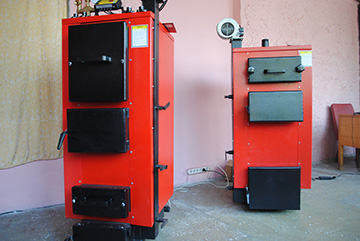
The device of the boiler for long burning from the inside
Horizontal fireboxes, as a rule, are lower and have a hob on top that gives off heat directly to the room. It is structurally possible to connect such boilers with a brick pipe or wells of a classic furnace, which significantly increases their heat transfer.
Brick wells that conduct hot flue gases not only increase the efficiency of the combustible fuel, preventing the gases from escaping directly into the street, but also serve as heat accumulators.
Top burning boiler
Its very name suggests that here the combustion process goes the other way around: from top to bottom. This is done in order to slow down the burning of fuel, as usually the flame goes up and ignites all the wood at once.
So, the design of this apparatus: a vertically standing pipe, more precisely, two pipes of large diameter, included one into one. Between them is a water jacket.
To supply air in this design, a telescopic pipe is provided, which rises up before laying fuel and descends with it in the course of burning wood or coal. To make such a design you will need:

- Pipes for the case with a diameter of 450 and 400 mm.
- For air preheating chamber with a diameter of 280 and a length of 350 mm.
- For a telescopic supply pipe, lengths of approximately 300 mm in such a diameter that they fit into each other are 89 mm, 76 mm, and 60 mm.
- And thick sheet metal for the manufacture of doors; for a pancake, which presses on the fuel and transfers air to it for combustion; for closing the top and bottom of the boiler, etc.
- The door for filling the fuel with a size of 250 x 210 is arranged at a distance of 579 mm from the base. At the very bottom there is another smaller door for cleaning. Grates are not provided in this model.
The “pancake” design is a hollow part of two identical disk washers with a diameter of 300–350 mm. Around the circumference, the discs are welded with a steel tape, so that air gets inside only through a 60 mm supply pipe. And to supply air to the firewood, many holes are drilled in the lower part of the disk.
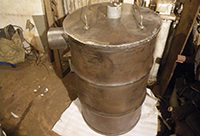 Long-burning boilers are much more expensive than their non-durable counterparts. To save money, you can assemble the structure yourself. : materials for manufacturing and features of operation.
Long-burning boilers are much more expensive than their non-durable counterparts. To save money, you can assemble the structure yourself. : materials for manufacturing and features of operation.
Read about how to properly design a roof heating system.
If you decide to build a two-story house, then in order for it to be warm and cozy, you need to properly organize the heating system. In this article, you will learn which schemes for heating a two-story house are used and what is the peculiarity of each of them.
Mine type
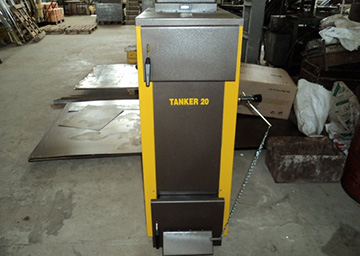 They differ in considerable height (can reach one and a half meters).
They differ in considerable height (can reach one and a half meters).
Firewood is stacked to its full height, ignited from below, where the combustion process takes place, and the torch of flame is sent to another section, connected at the bottom to the main boiler.
This design of the boiler allows the use of pyrolysis combustion. To do this, a damper is installed that limits the air supply, and is associated with a draft and temperature sensor. And in the second chamber, with the access of air, the combustion of the emitted gases occurs.
Mine-type boilers do well with damp firewood and sawdust. We can say that this is an ideal option for raw firewood.
Procedure for assembling a shaft-type boiler, step by step
Steel is suitable for manufacturing, with a thickness of at least 4 mm, preferably heat-resistant.
Elements of the inner side of the furnace and heat exchanger are installed on the base, tacked in several places. Then the back wall and supports for the grate are installed. The diagonals are carefully checked, and only after that the details are finally welded. After that, the heat exchanger pipes are mounted.
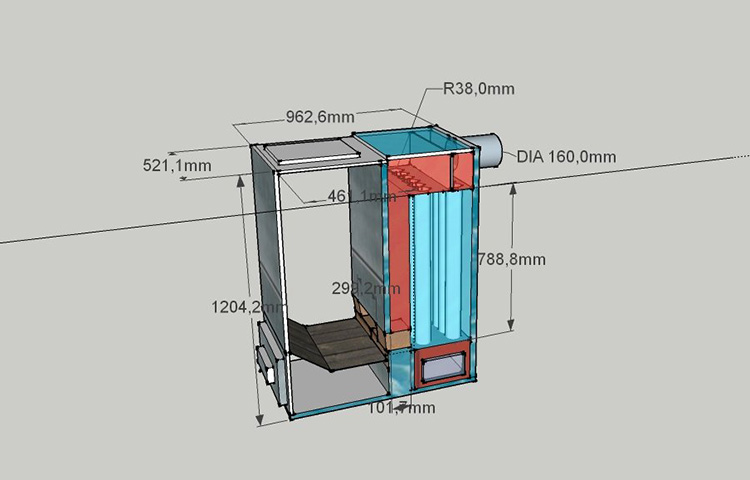
Drawing of a shaft-type boiler with measurements
The next step is to assemble the outer side of the boiler, which is both the water jacket and the lining. In a circle, through the spacer studs, so as not to inflate and lead in waves, the outer side is welded.
The chimney is led out through the rear wall so that a door for cleaning the second chamber can be installed on top. In general, three doors are obtained:
- Ash pan, for cleaning the ash of the slag and providing air access.
- Furnace, for loading firewood and sawdust (more convenient from above).
- For cleaning the second chamber and replacing the brick (top).
The secondary chamber is sometimes laid out with a brick, it heats up and helps to burn out the gases coming from the furnace.
It is also important to consider:
- Incorrect design will cause the unit to smoke at the moment of throwing firewood.
- This design is more suitable for installation in a boiler room separated from the living quarters.
- Since firewood must sink under its own weight as it burns, it is important to stack them correctly. Otherwise, the combustion stops.
- If you plan to use sawdust, then they need to be loaded on top of flared firewood (and it is desirable that the sawdust be dried). But coal for this model is extreme.
- In all seams and joints, the metal is applied with an allowance of 5 mm. This allows you to better weld the part on both sides.
- At the end of the work, all seams can be walked with welding sealant.
If you install a shaft boiler that is too powerful, you will have to limit the combustion force by cutting off the air supply, and this will lead to the formation of a large amount of condensate, which makes it difficult to clean the internal surfaces and reduces the life of the iron.
With pyrolysis combustion of solid fuel
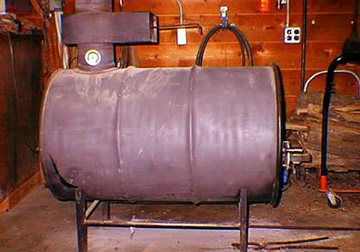 The pyrolysis boiler is similar to a conventional mine, with a grate and the usual ignition of firewood from below.
The pyrolysis boiler is similar to a conventional mine, with a grate and the usual ignition of firewood from below.
But it is characterized by the fact that the fuel does not burn in it, but smolders, releasing gas, which later burns out separately (due to the supply of secondary air).
Such a unit has a water circuit, both in the combustion chamber and in the afterburner.
It is equipped with a draft sensor, dampers for adjusting the air supply and, in some models, a fan for forcing it. A properly configured heater has a high percentage of heat transfer.
The pyrolysis boiler requires dry fuel - ideally, if the humidity is up to 10%.
Conclusion
Factory long-burning boilers are often made of cast iron, which greatly increases its durability. But they are produced by casting, inaccessible to the home master. Steel is less durable, prone to corrosion, so the service life of a furnace of our own production will be about 10 years.